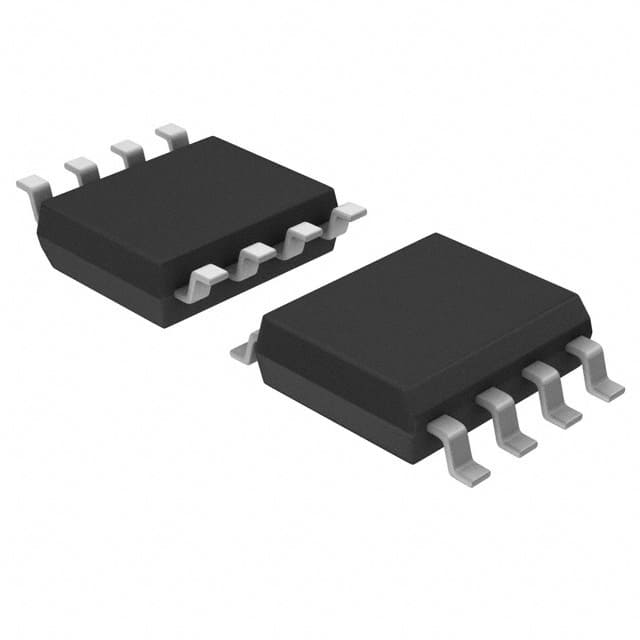Consulte las especificaciones para obtener detalles del producto.

ATTINY13V-10SU
Product Overview
Category
The ATTINY13V-10SU belongs to the category of microcontrollers.
Use
This microcontroller is commonly used in various electronic devices and applications that require embedded control systems.
Characteristics
- Low-power consumption
- High-performance 8-bit AVR microcontroller
- Compact size
- Wide operating voltage range
- Flash memory for program storage
- EEPROM for data storage
- In-system programmable
- Multiple I/O pins for interfacing with external components
Package
The ATTINY13V-10SU is available in a surface-mount package, specifically the SOIC-8 (Small Outline Integrated Circuit) package.
Essence
The essence of the ATTINY13V-10SU lies in its ability to provide efficient and reliable control capabilities in a compact form factor, making it suitable for various applications where space and power consumption are critical factors.
Packaging/Quantity
The ATTINY13V-10SU is typically packaged in reels or tubes, containing a quantity of 250 or 300 units per package.
Specifications
- Microcontroller Architecture: AVR
- CPU Speed: 10 MHz
- Flash Memory: 1 KB
- RAM: 64 Bytes
- EEPROM: 64 Bytes
- Operating Voltage Range: 1.8V - 5.5V
- Digital I/O Pins: 6
- Analog Input Pins: 4
- PWM Channels: 2
- Communication Interfaces: SPI, USART
- Timers/Counters: 1 x 8-bit, 1 x 16-bit
- Operating Temperature Range: -40°C to +85°C
Detailed Pin Configuration
The ATTINY13V-10SU has a total of 8 pins, which are assigned specific functions as follows:
- VCC: Power supply voltage input
- GND: Ground reference
- PB5 (RESET): Reset pin for restarting the microcontroller
- PB3 (MISO/DO): Master In Slave Out / Data Output pin for SPI communication
- PB4 (SCK/SCL): Serial Clock / Serial Clock Line pin for SPI or I2C communication
- PB0 (MOSI/DI/SDA): Master Out Slave In / Data Input / Serial Data Line pin for SPI or I2C communication
- PB1 (OC0A): Output Compare Match A pin for PWM output
- PB2 (OC0B): Output Compare Match B pin for PWM output
Functional Features
- Low-power consumption: The ATTINY13V-10SU is designed to operate efficiently with minimal power requirements, making it suitable for battery-powered applications.
- In-system programmable: The microcontroller can be programmed while it is connected to the target system, allowing for easy updates and modifications.
- Multiple I/O pins: The ATTINY13V-10SU provides a sufficient number of digital and analog I/O pins for interfacing with external components and sensors.
- Communication interfaces: It supports SPI and USART communication protocols, enabling seamless integration with other devices.
- Timers/Counters: The microcontroller features timers/counters that can be utilized for precise timing and event counting.
Advantages and Disadvantages
Advantages
- Compact size and low-power consumption make it suitable for portable and battery-powered applications.
- In-system programmability allows for easy updates and modifications.
- Wide operating voltage range enhances compatibility with various power sources.
- Sufficient I/O pins enable versatile interfacing capabilities.
- Support for communication interfaces facilitates integration with other devices.
Disadvantages
- Limited program memory and RAM may restrict the complexity of applications.
- Limited number of I/O pins may pose limitations in certain projects requiring extensive interfacing.
Working Principles
The ATTINY13V-10SU operates based on the AVR architecture, utilizing a RISC (Reduced Instruction Set Computer) design. It executes instructions stored in its flash memory, interacting with external components through its I/O pins. The microcontroller can be programmed using appropriate development tools and software, enabling the execution of specific tasks and control algorithms.
Detailed Application Field Plans
The ATTINY13V-10SU finds applications in various fields, including but not limited to: - Home automation systems - Consumer electronics - Industrial control systems - Internet of Things (IoT) devices - Sensor networks - Automotive electronics - Medical devices
Detailed and Complete Alternative Models
- ATTINY25V-10SU: Similar features and specifications, but with increased program memory and I/O pins.
- ATTINY85-20PU: Higher clock speed and more program memory, suitable for more complex applications.
- ATTINY2313A-PU: Enhanced capabilities with additional peripherals and larger program memory.
These alternative models provide options with varying capabilities to suit different project
Enumere 10 preguntas y respuestas comunes relacionadas con la aplicación de ATTINY13V-10SU en soluciones técnicas
Sure! Here are 10 common questions and answers related to the application of ATTINY13V-10SU in technical solutions:
Q: What is the ATTINY13V-10SU microcontroller used for? A: The ATTINY13V-10SU is a low-power, high-performance microcontroller commonly used in various embedded systems and IoT applications.
Q: What is the operating voltage range of the ATTINY13V-10SU? A: The ATTINY13V-10SU operates within a voltage range of 1.8V to 5.5V.
Q: How many I/O pins does the ATTINY13V-10SU have? A: The ATTINY13V-10SU has a total of 6 I/O pins, which can be configured as either digital inputs or outputs.
Q: What is the maximum clock frequency supported by the ATTINY13V-10SU? A: The ATTINY13V-10SU supports a maximum clock frequency of 10 MHz.
Q: Can the ATTINY13V-10SU be programmed using the Arduino IDE? A: Yes, the ATTINY13V-10SU can be programmed using the Arduino IDE with the help of an external programmer.
Q: Does the ATTINY13V-10SU have built-in analog-to-digital converters (ADC)? A: Yes, the ATTINY13V-10SU has a single 10-bit ADC channel, allowing it to convert analog signals into digital values.
Q: What programming languages can be used to program the ATTINY13V-10SU? A: The ATTINY13V-10SU can be programmed using C/C++ language with the help of development tools like Atmel Studio or Arduino IDE.
Q: Can the ATTINY13V-10SU communicate with other devices using serial communication protocols? A: Yes, the ATTINY13V-10SU supports serial communication protocols like I2C and SPI, allowing it to communicate with other devices such as sensors and displays.
Q: What is the flash memory size of the ATTINY13V-10SU? A: The ATTINY13V-10SU has a flash memory size of 1KB, which can be used to store program code.
Q: Is the ATTINY13V-10SU suitable for battery-powered applications? A: Yes, the ATTINY13V-10SU is designed to operate at low power and has various power-saving features, making it ideal for battery-powered applications.
Please note that these answers are general and may vary depending on specific application requirements and configurations.

